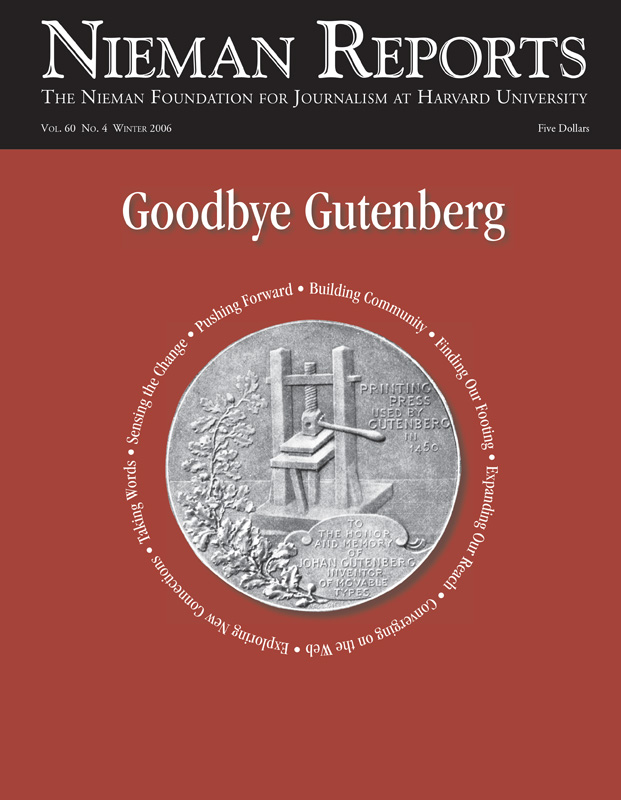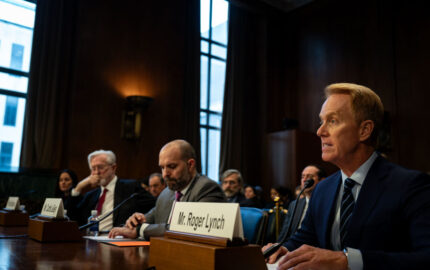
Ten years ago this October, The Associated Press (AP) launched its first multimedia service for the Internet. Appropriately, it was called "The Wire," and it quickly enabled hundreds of AP affiliate newspapers and broadcasters to display breaking news on the Web in a format that linked text stories with photos, audio, video and motion graphics.
For its time, The Wire was cutting edge. It provided news in real time, instead of in tomorrow morning's newspaper. Video, despite painfully slow dial-up connections, was available on demand on the PC and not just by appointment on the tube at 6 and 11 p.m.
It was a time when everything we thought we knew about the news was about to change. Just a decade later, it has.
Fast forward to 2006, and we are still coming to grips with the revolution those early days unleashed. Even those of us who have been along for the whole ride have been surprised by the magnitude of the speed and the bumps. It was supposed to be just another medium, like the coming of radio and, later, TV. But the Web turned out to be so much more, even in spite of a sudden collapse midway through its first decade.
In 1996, it was all about "repurposing"—taking what had already been produced for an established medium (the newspaper, radio and television) and repackaging it for the Web. What's more, we all aped the "news by appointment" model, expecting Web viewers to "bookmark" news sites like loyal subscribers and return day-in and day-out when they "logged on" to the new-fangled Internet.
We were in for a shock. We managed to enjoy a few years of subscription-like viewing, but when the 9/11 attacks brought unprecedented numbers of people online, the bookmarked sites couldn't keep up. And a geeky little search engine called Google taught the world how to "search" for news, instead of subscribe. We've been playing catch-up ever since.
The Internet of 2006—many call it "Web 2.0"—is no longer repurposed. It is chock-full of original content, produced more by the audience than by professionals, and on-demand access has permanently replaced the quaint notion of surfing the Web. Hardly anyone under the age of 25 knows any other way to consume the news. You can bet that most of them won't be padding out to the driveway for their morning newspapers or tuning into the network TV news in the years ahead, as their parents and grandparents were conditioned to do.
This new generation of news consumers is already aggregating and sharing news across multiple screens (handheld, desktop and set-top) and adding their own comments and original coverage to a new media ecosystem where consumers, creators and distributors of content all share power.
Will the so-called "mainstream media" survive this revolution? Almost certainly—but not without some radical adjustments to their news reports and business strategies.
The Old Meets the New
At The Associated Press, the world's oldest and largest news agency, the challenge is huge. We had just reached the peak of our "old" media model when the Internet turned it upside down. For a century and a half, we had carefully built up strong, media-centric businesses—one to churn out text and photos for newspapers, another repurposing the text for radio and adding audio, and a third repurposing all that and adding video. Each business had its own journalists, its own production and distribution system, even its own business administration.
Those were the days. We could chase a story for print and give a polite nod to our colleagues from broadcast at the scene, each flank confident that AP's customers and audience would be ably served by one media type or the other. Today, the demands are entirely different. Journalists are organized and deployed across media type, and content flows into a single database for production and distribution. Our customer base, too, has changed. We serve AOL, Yahoo! and scores of new media companies in addition to newspapers and broadcasters.
Since 2003, coinciding with the arrival of new Chief Executive Officer Tom Curley, the AP has been on a mission to make an uncompromising digital shift. That mission has necessitated a total overhaul of our strategy so that we put online news production ahead of other formats.
Embracing new technology has been key to that transformation, and we are installing new engines in the AP jumbo jet even as we keep flying it. We have our multimedia database in place and are in the process of retiring the old legacy systems that served up one media type at a time. The database combines—and cross-references—stories, photos, graphics, audio and video, and it can be searched via a password-protected browser by our journalists and customers alike.
The shift is enabling changes in our business as well. With the database in place, AP can serve its core newspaper customers with more news content than ever before (video, for instance, in addition to text and photos) and many new customers—commercial Web sites, mobile networks, etc.—can be served worldwide by segmenting their access to particular slices of the same database. In the coming year, AP will make it possible for its member newspapers to share their own branded content with each other and to link to one another's Web sites by sending their stories and photos into the database to receive standardized "metadata."
The invisible, but machine-readable, metadata will be used to electronically tag everything from bylines and headlines to famous names in the body of the content, so that news from all providers can be automatically linked and accessed whenever a Web traveler searches or clicks for more related information on a news topic.
As Web 2.0 unfolds and becomes 3.0, 4.0 and beyond, the online environment will increasingly feed off search, links and sharing, and news providers need to harness that new energy and get into the new flow. The bottom line is that no publishing or broadcasting "container" will be strong enough to maintain a hold on any digital content of value. No printed paper, no scheduled television broadcast, no bookmarked Web site will be able to match the power of the user and his or her search "remote." Indeed, if content is to realize its true value in a search-driven economy, it must meet users wherever they are.
Research firms have been telling us for more than a year that we must change to meet the new needs of the online audience:
- Forrester urged its media clients at the end of 2005 to prepare for a future defined by search and other Web-based software programs for accessing and manipulating content on the fly.
- Gartner proclaimed in December 2005 that search would become the "main entry point into a content experience" by 2008 and that "architectural planning [by content providers] must begin in the next 18 months."
- Outsell, in a March 2006 alert, advised its news industry clients to pursue "three-year transition plans" to digital platforms and strategies, or risk being left behind.
The stock market then chimed in with an even more brutal message, as it pounded and, in some cases, dismembered old media companies whose responses to the online shift were too slow.
When we talk about the challenges ahead of us at AP, we often reflect on the circumstances surrounding our birth in 1846, when the smart founders of the agency organized around the telegraph—the Internet of its day. Back then, the telegraph so dramatically improved the gathering and distribution of the news that old solutions—pony express, pigeon carriers, and the mail—were rendered quickly, almost comically, obsolete.
Such is the magnitude of the change now upon us. "The wire" of the next century and a half will be plugged into a database that will be able to deliver almost any kind of news experience, from text headlines to rich images and sounds.
Has AP completed the transformation necessary to enable that new world of newsgathering and consumption? Not yet. But the next two to three years will be an exciting time to be inside the walls of a big mainstream media company—because those walls are coming down.
Jim Kennedy is vice president and director of strategic planning at The Associated Press.


